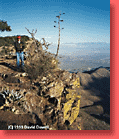D
o u g S p e h e g e r
Although it took me a while to realize it, the moment that got me into meteorology occurred on April 3, 1974. This is the date of the largest outbreak of tornadoes recorded in the United States. 148 tornadoes hit 13 states, including Indiana, where I lived. My town was not hit directly, but one of the large tornadoes of that day hit the nearby town of Monticello, Indiana. After seeing the damage caused by this tornado, I developed an interest in weather and storms. Through high school, I had an interest in science and math, but did not know what I wanted to do. I worked as a disc jockey on a local radio station and there were a few times when I was on the radio when severe weather would move through. Reading the severe thunderstorm warnings on the radio helped to enhance my interest in weather and storms. I finally decided that this is the path that I wanted to take when I was a senior in high school.
I received my Bachelors Degree in Atmospheric Science at Purdue University, then moved to Norman, Oklahoma to attend graduate school at the University of Oklahoma (OU). Here I had the good fortune of joining the tornado research team with Dr. Howard Bluestein. The goal of our team was to set up a portable Doppler radar within a couple of miles of a tornado, and use the radar to measure the wind speeds of the tornadoes. Using this radar, we were able to take measurements of 5 tornadoes in 1991, including a large, violent tornado that moved through northern Oklahoma, near the community of Red Rock. I began work at the National Weather Service Forecast Office in Norman in 1993 and finally finished my Masters Degree in 1994. The National Weather Service has a number of forecast offices across the country, each making the day-to-day forecasts for the public and for aviation for a specific portion of the country. And when thunderstorms develop, the forecast offices will watch the radar and issue "Severe Thunderstorm Warnings" or "Tornado Warnings" when the storms look like they may produce severe weather.
The office in Norman is responsible for the western two-thirds of Oklahoma (except the panhandle), and a small area of north Texas near Wichita Falls. I enjoy being able to use what I learned from the OU tornado research team and apply that to help me interpret what I see on radar, and to warn people when damaging weather may occur. I still will go out and track thunderstorms in the field when I have a day off so that I can continue to teach myself how thunderstorms work. I was one of the warning forecasters when a large outbreak of tornadoes hit Oklahoma on May 3, 1999. About 60 tornadoes were spawned across the state, including a large, violent F5 tornado that hit the Oklahoma City metropolitan area. Unfortunately, over 40 people were killed by the tornadoes on this day. But later in the week when I was surveying the tornado damage, the destruction was so great in some areas that I was surprised that many, many more people weren't killed by these devastating tornadoes. A lot of people knew the storms were coming and took shelter, and it felt good that I was part of the team that helped to warn them of the destructive weather that was occurring. (Ed Note: To read what it is like in our office when severe weather and tornadoes are occurring, read the JOURNAL from Geoff Haines-Stiles on this web site. And to see what May 3rd looked like-and how to stay safe in tornadoes, be sure to view LIVE FROM THE STORM program 2.)
Away from work, I play basketball and enjoy music-both listening to and singing in a church choir. I was a member of the Ultimate frisbee team at Purdue University, which is a great sport. I also enjoy traveling and hiking, especially to naturally scenic areas and mountains. I've recently spent time in Big Bend National Park in Texas, Seattle and the Cascade Mountains of the Pacific Northwest, the Florida everglades, and various places along the Colorado Rockies. |



